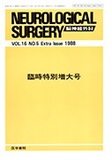Japanese
English
研究 手術・治療・外傷
―研究―視床出血に対するCT guided stereotaxic operationの効果
A Comparison between Stereotaxic Operation and Conservative Therapy for Thalamic Hemorrhage
本田 英一郎
1
,
林 隆士
1
,
島本 宝哲
2
,
原 邦忠
2
,
森高 一彦
2
,
佐藤 能啓
3
Eiichiro HONDA
1
,
Takashi HAYASHI
1
,
Hotetsu SHIMAMOTO
2
,
Kunitada HARA
2
,
Kazuhiko MORITAKA
2
,
Yoshihiro SATO
3
1聖マリア病院脳神経外科
2久留米大学脳神経外科
3聖マリア病院神経内科
1Department of Neurosurgery, St. Mary's Hospital
2Department of Neurosurgery, Kurume University School of Medicine
3Department of Neurology, St. Mary's Hospital
キーワード:
Stereotaxic operation
,
Thalamic hemorrhage
,
Outcome
,
CT classification
Keyword:
Stereotaxic operation
,
Thalamic hemorrhage
,
Outcome
,
CT classification
pp.665-670
発行日 1988年5月1日
Published Date 1988/5/1
DOI https://doi.org/10.11477/mf.1436202619
- 有料閲覧
- Abstract 文献概要
- 1ページ目 Look Inside
I.はじめに
視床出血に対し,開頭による外科的アプローチも数々報告されているが,深部であるために脳実質の損傷も大きく,リスクも高いため,必ずしも有効な手段とはいえない.
視床出血は全身的な合併症(心臓病,糖尿病など)を伴った老人に発症しやすく,治療に際しても侵襲を最少にせねばならない.
The subjects studied in this report included 17 surgical cases which underwent evacuation of hematoma by means of BRW CT stereotaxic system approximately 14 days after its onset, and 11 non-operated cases. The average age was 65.5 years for the operated and 68.7 years for the non-operated groups. The neurological grades on admission were Grade III or above (slight or mild disturbance of consciousness).

Copyright © 1988, Igaku-Shoin Ltd. All rights reserved.


